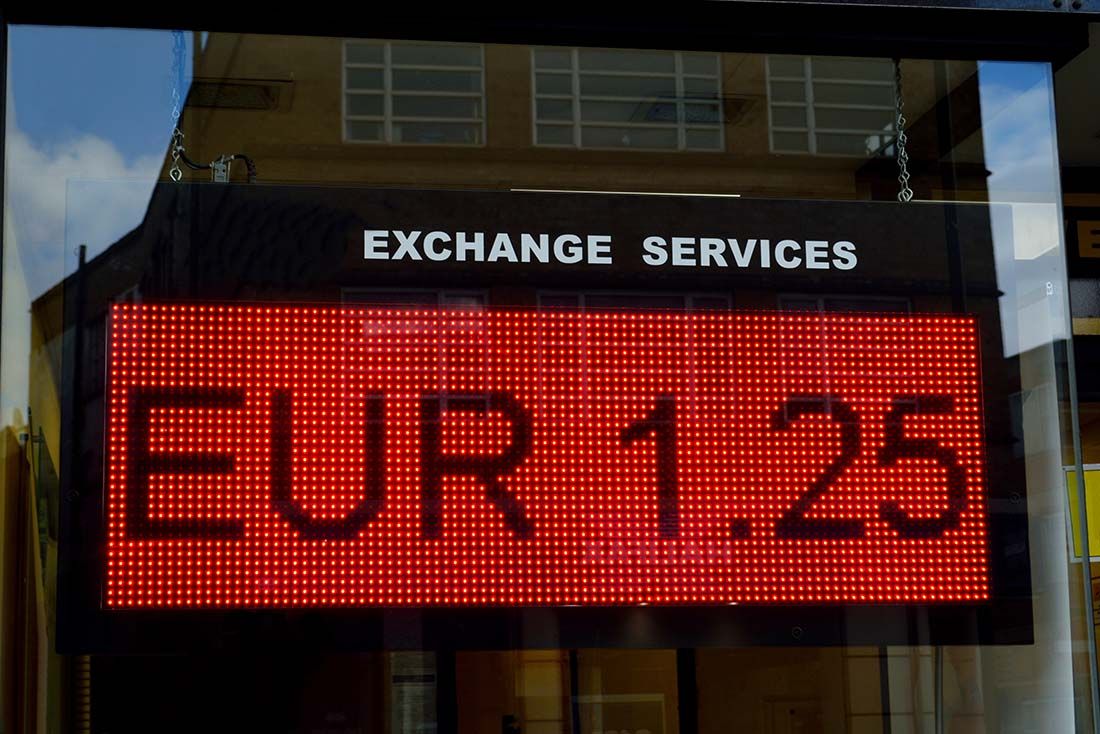The Pound-to-Euro Rate Week Ahead Forecast: Trading with a Bearish Bias
- GBP/EUR trades at bottom of long-term range.
- Bearish outlook, continuation to 1.10 is possible.
- Bank of England, Euro area PMI surveys in focus.

© Savo Ilic, Adobe Stock
The Pound-to-Euro rate continues to trade beneath the lower end of its long-term channel, with a bearish bias heading into the new week.
Channel breakouts normally extend by a ratio of 0.618 times the height of the channel extrapolated from the break-point lower, which in this case indicates an eventual downside target of 1.1025. The pair has already reached 1.1076.

Above: Pound-to-Euro rate shown at weekly intervals. Captures earlier channel break.
The week before last the exchange rate formed a hammer candlestick pattern, which is a bullish reversal sign.
However, hammers are only reliable indicators if they are followed by another bullish candle, which was not the case with the Pound-to-Euro rate last week, which ended bearishly.

Above: Pound-to-Euro rate shown at daily intervals. Captures earlier channel break.
The exchange rate's inability to break back inside the channel range suggests a weak outlook for the pair, with further declines still likely, at least from a technical perspective.
The Pound: What to Watch
The main event for the Pound in the week ahead will be testimony from Bank of England (BOE) governor Mark Carney the Parliamentary Treasury Select Committee, on Wednesday, August 22, covering the inflation and economic outlook.
Although the BOE raised interest rates at the start of August, the chances of a further hike in the short term are generally viewed as low mainly given the increasing uncertainty around Brexit. Carney recently said the chances of a 'no-deal' Brexit were "uncomfortably high" and that this presents a risk to the economy.
The Pound is highly correlated with interest rates because of their influence over foreign capital inflows. Higher rates tend to attract greater inflows of capital, which raises demand for Sterling. Therefore, traders will be analysing Carney's statements for clues on when rates might change again, even if more clarity is unlikely.
The other major release for the Pound is the Confederation of British Industry (CBI) Industrial Trends report for August, with overall activity balance forecast to decline from 11.0 to 10.0 when the report is released on Tuesday, August 21 at 11.00 B.S.T.
CBI surveys are often closely followed by the market due to their timeliness and can provide early insight into activity within the economy.
The Euro: What to Watch
The main release for the Euro in the week ahead is preliminary manufacturing and services PMIs from IHS Markit for the month of August, out at 9.30 B.S.T on Thursday, August 23.
August's Eurozone manufacturing PMI is expected to remain unchanged at 55.1 and the services index is forecast to rise marginally to 54.4, from 54.2 previously. The composite of the two is expected to remain at 54.3.
PMI surveys measure changes in industry activity by asking respondents to rate conditions for employment, production, new orders, prices, deliveries and inventories. A number above the 50.0 level indicates industry expansion while a number below is consistent with contraction.
PMIs in the Eurozone have been declining steadily since peaking in the early 60s at the end of 2017, so a continuation lower would reinforce the generally more downbeat expectations for growth in the region in 2018 and potentially weigh on the Euro.
The other major release for the Euro is the minutes of the July 26 European Central Bank (ECB), which are due out on Thursday at 12.30.
The minutes provide details of the governing council's latest meeting and are important to analysts and traders as they can yield clues about future changes in monetary policy.
Specifically, traders will be looking for hints about whether the ECB is getting cold feet about exiting its bond buying programme, as well as clues as to exactly when the bank will be willing to consider an initial interest rate rise.
Currently, markets expect the bond buying programme to come to an end in December and for interest rates to rise after the "end of summer 2019".
ECB president Mario Draghi was quite upbeat at the last meeting, saying he expects Eurozone inflation to continue converging with the ECB's target of just below 2.0% regardless of whether QE is continued.
Advertisement
Get up to 5% more foreign exchange by using a specialist provider to get closer to the real market rate and avoid the gaping spreads charged by your bank when providing currency. Learn more here




